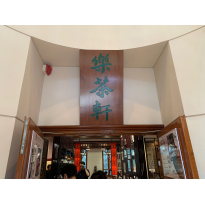Located in Admiralty, the Hong Kong Tea Wares Museum has celebrated its 40th anniversary. Over the years, with the emergence of various new art facilities such as the West Kowloon Cultural District, Central Market, and Tai Kwun, its significance has gradually been overlooked, leading to a decline in visitors. As an enthusiast of antique culture and art, I believe that over the years, the Tea Utensils Museum and its attached Tea Art Gallery have indeed made significant contributions to the dissemination of relevant artistic and cultural heritage in Hong Kong, deserving of recognition by all. The Hong Kong Tea Utensils Museum resembles a beautiful maiden in a white dress, quietly sitting on a lush hillside, awaiting the arrival and solace of visitors.
Located on a hillside in the southeast of Hong Kong Park, the Tea Utensils Museum was originally the official residence of the British Commander-in-Chief, also known as the Flagstaff House. After the Opium Wars, during the early years of the colonial government when the Governor was not yet confirmed, the Commander-in-Chief was the highest authority in Hong Kong. Every day, there were grand ceremonies to raise the British flag at the official residence, symbolizing national sovereignty. The museum is a two-story white building with doors and windows made of solid wood, exuding a classical style.
Established in 1984, this year marks the 40th anniversary celebration. In 1981, Mr. Lo Kwai Cheung, a donor of tea utensils, donated his collection of 476 exquisite tea utensils to the Urban Council. The government decided to house them here. After several years of renovation and maintenance, the Flagstaff House was officially opened to the public as the Tea Utensils Museum. The exhibited items include tea-drinking culture and utensils from the Tang and Song dynasties, which are exquisite and delightful. Among them are many Yixing teapots, a significant part of Chinese tea culture since the Ming and Qing dynasties.
Mr. Lo Kwai Cheung (1910-1995), originally from Meizhou, Guangdong, was the founder and major shareholder of Vitasoy International Holdings Ltd., holding one-third of the shares. During the economic downturn in post-war Hong Kong, his Vitasoy was nutritious and affordable, which led to rapid business growth. With a keen business sense, Mr. Lo understood the importance of product diversification. In the 1970s, he introduced malted Vitasoy, which became an essential part of breakfast for many young students, especially in the cold winters when heated in refrigerators. As a witness during my youth, the memories are still fresh! Mr. Lo Kwai Cheung graduated from the University of Hong Kong with a degree in economics. Under his leadership, "Vitasoy is more than just soda" became increasingly successful, eventually listing on the Hong Kong Stock Exchange.
In addition to the museum, Mr. Lo established a family foundation in his early years to manage the family's cultural assets. He believed that the most important aspect of collecting was to exhibit it to the public, promoting cultural charm, rather than keeping it private. Therefore, in 1994, he made another significant gesture by donating 25 pieces of privately collected antique porcelain, including rare pieces from the Song, Yuan, Ming, and Qing dynasties, to the Urban Council! To exhibit these collections, a new venue, the Tea Art Gallery, was built and inaugurated in 1995. The newly constructed Tea Art Gallery is also a two-story high ancient-style building with a white exterior, particularly striking in the sunlight.
Although the collection at the Tea Art Gallery is not extensive, it includes the five famous kilns of the Song Dynasty, such as the Ru Kiln and the Ge Kiln, as well as blue and white porcelain from the Yuan and Ming dynasties. In this small space, one can admire these unique, superbly crafted, and renowned artworks from the past, making it a truly rare opportunity. Additionally, there are many Shoushan stone seals from the Ming and Qing dynasties on display, including those carved by famous engraver Cheng Sui during the late Ming and early Qing dynasties, as well as those by renowned painter Qi Baishi, which I personally admire. These seals exhibit superb carving techniques and unique personal styles, truly worth our slow appreciation!
The Hong Kong Tea Utensils Museum not only exhibits exquisite tea utensils and related cultural relics but also regularly organizes tea art performances, lectures, and workshops, providing visitors with opportunities to deepen their understanding and experience of tea culture. Let us extend warm blessings to it on its 40th anniversary, and may it continue to strive forward in the future, playing a greater role in promoting Chinese tea culture and becoming a beloved museum in Hong Kong!
Author
Mr. Robert T Li graduated from the Economics Department of the University of Hong Kong and has served as the Head of Liability Insurance in the Greater China region for an international insurance company. He has a passion for traditional Chinese culture and enjoys collecting art. He is actively involved in promoting awareness of traditional Chinese culture, music, and art among young people. He can be contacted at litaichai@gmail.com.
Uploaded on 2024.4.2




